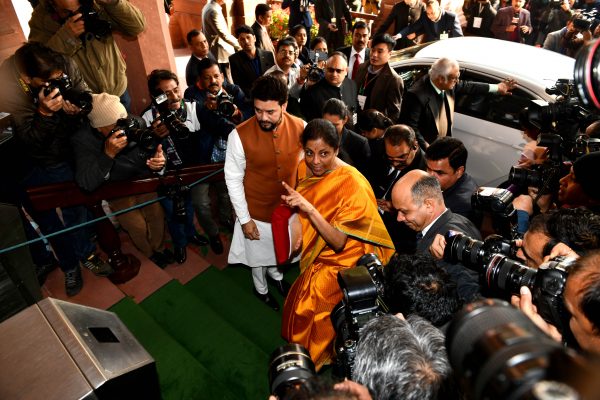Despite the budget’s long-run focus and conservativism, it did include many measures to reverse the slowdown. But these were not clearly articulated. Since the budget stayed within the spending limits mandated by the Fiscal Responsibility and Budget Management (FRBM) Act — enacted to set fiscal deficit targets for the government — the markets took this to imply the absence of widely expected countercyclical measures.
But the markets may have slumped even if there was a departure from the FRBM Act due to fears of uncontrollable deficits. This left the budget performing a difficult balancing act.
Stimulus measures taken to boost economic growth included first, the government invoked the FRBM Act escape clause to allow a 0.5 per cent rise in the fiscal deficit for the next two years. The magic of a US$3 trillion economy is that even 0.5 per cent of GDP amounts to a large increase in absolute dollars available for spending.
Second, there are attempts to maintain expenditure and improve its quality by restructuring towards expenditure with higher multipliers, such as tax cuts, rural transfers and infrastructure spending on rural roads and low-income housing. For example, the growth in tax revenue was only 1.4 per cent against a budget estimate of 11.4 per cent, as nominal income growth was far below the forecasted 11 per cent. The rise in expenditure of 9.8 per cent was also lower than the budget estimate of 13.4 per cent, but the shortfall was less than that in tax revenue.
Capital expenditure growth of 10.2 per cent was higher than the budget estimate of 6.9 per cent. It was financed by a rise in capital receipts and borrowings and a fall in interest payments. Capital expenditure growth of 18 per cent is slated for next year while total expenditure is expected to increase 12 per cent.
Third, borrowings from small savings were used to finance part of the Finance Corporation of India’s (FCI) food subsidies, so they were not included in the fiscal deficit. Since small savings are not available to the private sector, using them need not crowd out private borrowing, allowing stimulus to exceed the fiscal deficit.
Moreover, extreme risk aversion is limiting lending to industry. Only credit to government and quasi-government agencies showed respectable growth last year and was essential in keeping the economy afloat. The current FRBM Act is too rigid. Inadequate countercyclical spending makes it more difficult to achieve fiscal consolidation as growth and revenues fall.
Fourth, income tax cuts for lower slabs puts more money in the hands of people who are likely to spend it faster, as does large planned rural spending. The PM-Kisan scheme that provides small farmers income support is expected to be more effective in its second year.
Sitharaman’s budget speech emphasised the continuation of reform and initiatives for systemic improvements. For example, promoting prepaid smart metering over the next three years will give consumers the freedom to choose suppliers and help resolve the issue of energy distribution company viability.
The focus on creating opportunities for youth will create jobs and raise productivity. Major reforms in government recruitment will reduce duplication and improve the set of skills available.
The thrust towards corruption-free governance based on trust is also commendable. The announced taxpayer charter, incentives to close tax litigation, removal of criminal liabilities for business activities and the use of technology for faceless assessment and appeal are all systemic changes that move towards this goal.
There is a push to continue the initiatives from the last budget to strengthen the financial sector, but the absence of big moves for stressed sectors has disappointed markets. There is a tension, however, between doing more in the budget and retaining the flexibility to respond to evolving situations through sustained stakeholder engagement.
For example, schemes to improve non-banking financial companies’ (NBFCs) liquidity access have been extended to smaller NBFCs in response to complaints that they were previously excluded. It is important to listen to markets and, rather than accommodating narrow interests, make operational improvements and take action where systemic spillovers would otherwise occur.
It is also important to remember that further opening of government and corporate bond markets to foreign investors can cause volatility. Deep domestic markets are a precondition for, and not a consequence of, such flows. Foreign debt must also be repaid in hard currency, so using it to build export capability is essential.
Since there are signs of a turnaround in growth, the forecasted nominal income growth of 10 per cent is likely to be realised this year and inflation is likely to anchor around 4 per cent. It will be important to continue front-loading government expenditure. While the Direct Benefit Transfer (DBT) scheme reduces leakages, government payments must be made in time to keep money circulating in the economy.
The government must aggressively pursue privatisation to keep the fiscal deficit in check and direct funds toward productive expenditure. Corporatisation of public sector enterprises transforms them into profitable, independent entities that are free to raise resources in the market as required.
The shift to accrual budgeting is a long overdue reform that would enhance the credibility of the budgeting process, as would incorporating more realistic countercyclical measures in the FRBM. Rationalising unproductive subsidies and falling interest payments as the central bank acts to reduce spreads will lower revenue deficits. The transparency about off balance sheet financing and plans to continue fiscal consolidation already improves credibility.
Ashima Goyal is Professor of Economics at the Indira Gandhi Institute for Development Research (IGIDR).
A version of this article originally appeared here on The Hindu Business Line.

